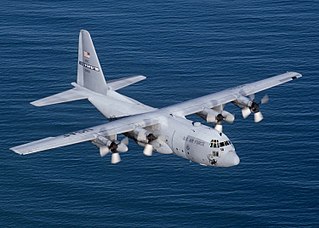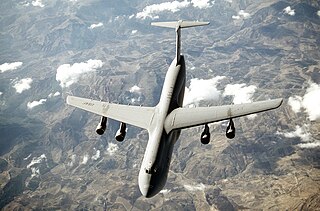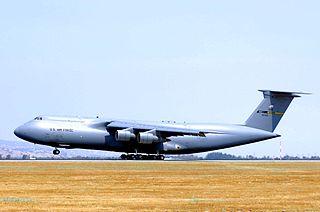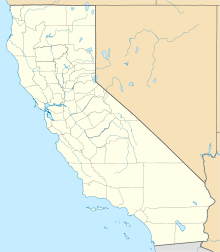
The Lockheed C-130 Hercules is an American four-engine turboprop military transport aircraft designed and built originally by Lockheed. Capable of using unprepared runways for takeoffs and landings, the C-130 was originally designed as a troop, medevac, and cargo transport aircraft. The versatile airframe has found uses in a variety of other roles, including as a gunship (AC-130), for airborne assault, search and rescue, scientific research support, weather reconnaissance, aerial refueling, maritime patrol, and aerial firefighting. It is now the main tactical airlifter for many military forces worldwide. More than 40 variants of the Hercules, including civilian versions marketed as the Lockheed L-100, operate in more than 60 nations.

McChord Field is a United States Air Force base in the northwest United States, in Pierce County, Washington. South of Tacoma, McChord Field is the home of the 62d Airlift Wing, Air Mobility Command, the field's primary mission being worldwide strategic airlift.

The Lockheed C-5 Galaxy is a large military transport aircraft originally designed and built by Lockheed, and now maintained and upgraded by its successor, Lockheed Martin. It provides the United States Air Force (USAF) with a heavy intercontinental-range strategic airlift capability, one that can carry outsized and oversized loads, including all air-certifiable cargo. The Galaxy has many similarities to the smaller Lockheed C-141 Starlifter and the later Boeing C-17 Globemaster III. The C-5 is among the largest military aircraft in the world.

The Douglas C-124 Globemaster II, nicknamed "Old Shaky", is a retired American heavy-lift cargo aircraft built by the Douglas Aircraft Company in Long Beach, California.

The Douglas C-133 Cargomaster is an American large turboprop cargo aircraft built between 1956 and 1961 by the Douglas Aircraft Company for use with the United States Air Force. The C-133 was the USAF's only production turboprop-powered strategic airlifter, entering service shortly after the Lockheed C-130 Hercules, which is designated a tactical airlifter. It provided airlift services in a wide range of applications, being replaced by the C-5 Galaxy in the early 1970s.

The Cessna O-2 Skymaster is a military version of the Cessna 337 Super Skymaster, used for forward air control (FAC) and psychological operations (PSYOPS) by the US military between 1967 and 2010.

The Douglas DC-6 is a piston-powered airliner and cargo aircraft built by the Douglas Aircraft Company from 1946 to 1958. Originally intended as a military transport near the end of World War II, it was reworked after the war to compete with the Lockheed Constellation in the long-range commercial transport market. More than 700 were built and many still fly today in cargo, military, and wildfire control roles.

The Lockheed Model 18 Lodestar is a passenger transport aircraft of the World War II era.

The Lockheed JetStar is a business jet produced from the early 1960s to the 1970s. The JetStar was the first dedicated business jet to enter service, as well as the only such airplane built by Lockheed. It was also one of the largest aircraft in the class for many years, seating ten plus two crew. It is distinguishable from other small jets by its four engines, mounted on the rear of the fuselage, and the "slipper"-style fuel tanks fixed to the wings.

The Lockheed C-141 Starlifter is a retired military strategic airlifter that served with the Military Air Transport Service (MATS), its successor organization the Military Airlift Command (MAC), and finally the Air Mobility Command (AMC) of the United States Air Force (USAF). The aircraft also served with airlift and air mobility wings of the Air Force Reserve (AFRES), later renamed Air Force Reserve Command (AFRC), the Air National Guard (ANG) and, later, one air mobility wing of the Air Education and Training Command (AETC) dedicated to C-141, C-5, C-17 and KC-135 training.

The March Field Air Museum is an aviation museum near Moreno Valley and Riverside, California, adjacent to March Air Reserve Base.

The Museum of Aviation is the second-largest aerospace museum of the United States Air Force. The museum is located just outside Warner Robins, Georgia, and near Robins Air Force Base. As of July 2019, the museum included four exhibit buildings and more than 85 historic aircraft, among other exhibits, on its 51 acres (21 ha). The museum is also the home of the Georgia Aviation Hall of Fame. Admission is free to the nearly half-million visitors each year, which makes it the fourth-most-visited museum of the United States Department of Defense.

The Aerospace Museum of California is a private non-profit aviation museum located in North Highlands, California, outside of Sacramento, California, on the grounds of the former McClellan Air Force Base. The museum has a 4.5-acre outdoor Air Park, indoor exhibit space, a classroom, theater, conference room, and gift shop. Featured displays include: authentic military and civilian aircraft, rockets, historic World War II artifacts, objects from the Apollo missions, and an extensive collection of piston and jet engines. The museum preserves the history of the former base while supporting current STEM educational standards through its programming and exhibits.

The 349th Air Mobility Wing is an Air Reserve Component of the United States Air Force. It is assigned to the Fourth Air Force, Air Force Reserve Command, stationed at Travis Air Force Base, California. The 349th AMW is an associate unit of the 60th Air Mobility Wing, Air Mobility Command (AMC) and if mobilized the wing is gained by AMC.

The 21st Airlift Squadron is part of the 60th Air Mobility Wing at Travis Air Force Base, California. It operates C-17 Globemaster III aircraft carrying out United States Air Force global transport missions, duties which involve airlift and airdrop missions as well as provision of services and support in order to promote quality of life for both soldiers and civilians in situations requiring humanitarian aid.

The 76th Airlift Squadron is part of the 86th Airlift Wing at Ramstein Air Base, Germany. It operates executive airlift aircraft, including the Learjet C-21A and Gulfstream C-37A Gulfstream V.

The 75th Expeditionary Airlift Squadron is a provisional Air Force squadron. It was most recently activated in May 2014 in Djibouti, where it provides airlift support for Combined Joint Task Force – Horn of Africa. It replaced the 52d Expeditionary Airlift Squadron.

The 20th Airlift Squadron is an inactive United States Air Force unit. Its last assignment was to the 60th Operations Group of Air Mobility Command at Travis Air Force Base, California, where it was inactivated on 31 December 1997.

The Air Mobility Command Museum (AMCM) is dedicated to military airlift and air refueling aircraft and the men and women who flew and maintained them. It has the largest and most complete collection of fully restored U.S. military cargo and tanker aircraft in the Eastern United States and is located about 1/2 mile south of Dover Air Force Base. The mission of the museum is to collect, preserve and exhibit the artifacts and human stories significant to the development and employment of military airlift and air refueling in the USAF and the USAAF, as well as to portray the history of Dover Air Force Base.

Travis Air Force Base is a United States Air Force air base under the operational control of the Air Mobility Command (AMC), located three miles east of the central business district of Fairfield, in Solano County, California, United States.

























